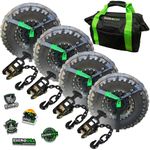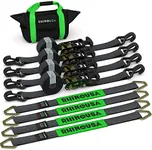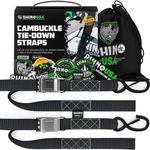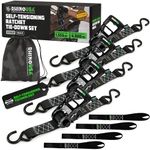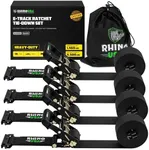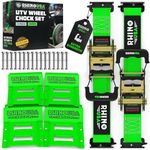Buying Guide for the Best Ratchet Straps
Choosing the right ratchet straps is important for safely securing loads during transport, whether you're moving furniture, tying down equipment, or hauling items on a trailer. The best ratchet strap for you depends on what you plan to secure, how heavy or bulky the load is, and how often you'll use the straps. Understanding the key features will help you pick a strap that is both safe and easy to use.Working Load Limit (WLL)The Working Load Limit, or WLL, tells you the maximum weight the strap can safely hold during normal use. This is important because using a strap with a WLL lower than your load can be dangerous and lead to accidents. WLL values are usually given in pounds or kilograms. Light-duty straps might have a WLL of a few hundred pounds, suitable for small items or light furniture. Medium-duty straps can handle several hundred to a thousand pounds, good for appliances or motorcycles. Heavy-duty straps can have WLLs of several thousand pounds, meant for large equipment or vehicles. To pick the right WLL, estimate the weight of your load and choose a strap with a WLL higher than that number for safety.
Strap WidthStrap width refers to how wide the strap is, usually measured in inches or millimeters. Wider straps generally offer more strength and distribute pressure more evenly, which helps protect your cargo from damage. Common widths are 1 inch, 1.5 inches, and 2 inches. Narrow straps are easier to handle and store, making them good for lighter loads or smaller items. Wider straps are better for heavy or bulky loads. Think about the size and weight of what you’re securing—if it’s large or heavy, go for a wider strap.
Strap LengthStrap length is how long the strap is from end to end, and it determines how big of a load you can wrap or tie down. Lengths can range from a few feet to over 20 feet. Shorter straps are easier to manage and are best for small loads or when you don’t need to wrap around large objects. Longer straps are more versatile and can handle bigger or oddly shaped loads, but they can be bulkier to store. Choose a length that’s a bit longer than you think you’ll need, so you have flexibility for different situations.
End FittingsEnd fittings are the hardware at the ends of the strap that attach to anchor points, such as hooks, loops, or flat hooks. The type of end fitting affects how and where you can secure the strap. S-hooks are common and easy to use for general purposes, while flat hooks or D-rings might be better for specific anchor points on trailers or trucks. Consider what you’ll be attaching the straps to—pick end fittings that match your anchor points for a secure hold.
Material QualityThe material of the strap, usually polyester or nylon, affects its strength, stretch, and durability. Polyester is popular because it resists stretching and holds up well in sunlight and wet conditions. Nylon is strong but can stretch more, which might not be ideal for all loads. Look for straps with tightly woven fibers and reinforced stitching for extra durability. If you’ll be using the straps outdoors or in tough conditions, prioritize weather-resistant materials.
Ratchet MechanismThe ratchet mechanism is the part you use to tighten the strap. A good ratchet should be easy to operate, smooth, and sturdy. Some ratchets are designed for quick release or have padded handles for comfort. If you’ll be using the straps often or for heavy loads, look for a ratchet that feels solid and is easy to use, even with gloves on. Test the mechanism if possible to make sure it locks securely and releases smoothly.

